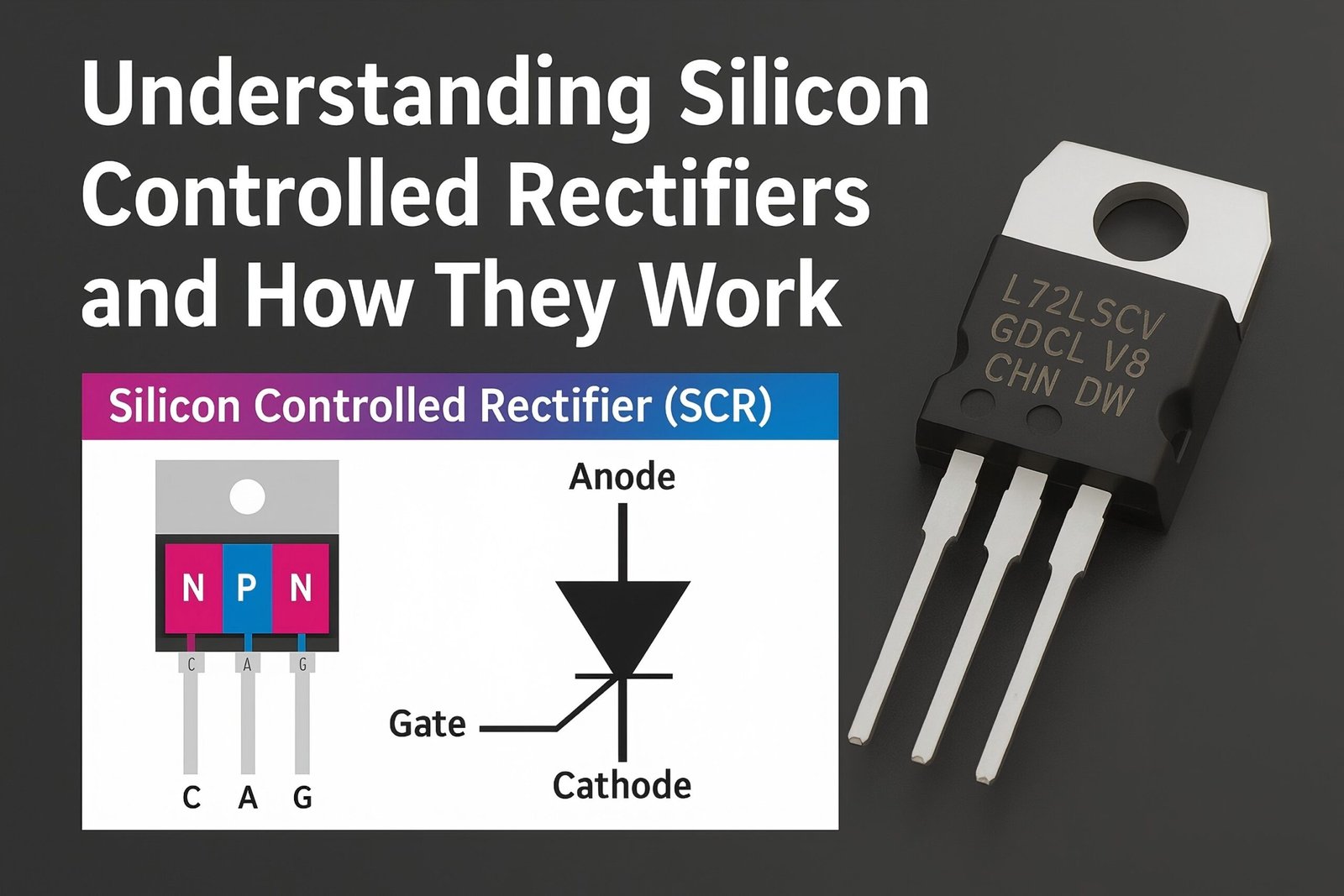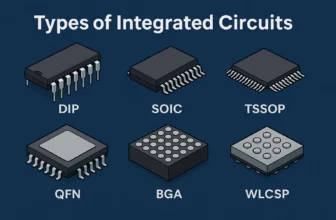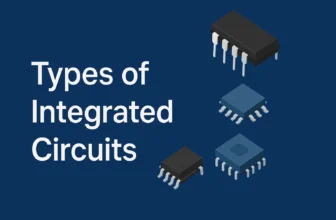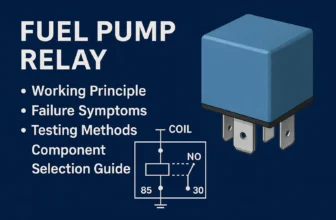
A silicon controlled rectifier lets you control the flow of electricity in a circuit by acting as a switch. You find three terminals on the device: anode, cathode, and gate. Four layers inside the SCR help it allow current in only one direction. When you send a signal to the gate, the switch turns on. People use silicon controlled rectifiers in many places:
- Electric appliances
- Lighting circuits for homes
- Motor speed control
- Light dimming
- Power regulation in AC and DC systems
- Overvoltage protection
- Power supplies
- Inverters
- Renewable energy systems
You see SCRs in products all over the world. The market reached USD 6.75 Billion in 2024 and may grow to USD 10.25 Billion by 2033.
Key Takeaways
- A silicon controlled rectifier (SCR) acts like a switch for electricity, controlling current flow in one direction.
- SCRs are used in various applications, including motor speed control, light dimming, and power regulation in both AC and DC systems.
- You can turn on an SCR with a small signal at the gate terminal, allowing it to control large amounts of power efficiently.
- SCRs have three main operating states: reverse blocking, forward blocking, and forward conducting, which help manage current flow.
- When choosing an SCR, consider its current and voltage ratings to ensure it meets your circuit’s needs.
Silicon Controlled Rectifier Basics
Definition
A thyristor (SCR) is a unidirectional semiconductor device made of silicon, consisting of three terminals: anode (A), cathode (K), and gate (G). It is constructed from alternating P-type and N-type materials, forming three PN junctions.
You can think of a silicon controlled rectifier as a special switch for electricity. It controls how current moves in a circuit. You use it in high-power systems to change AC current into DC current. This process is called rectification. The device only lets current flow in one direction. You can turn it on or off with a signal at the gate terminal.
- SCRs are unidirectional, allowing current to flow in one direction only.
- They cannot be used alone for full-wave AC power control.
- When used in a rectifier circuit, they enable controlled rectification by triggering at specific points in the AC waveform.
Structure
A silicon controlled rectifier has four layers inside. These layers alternate between P-type and N-type materials. The layers form three PN junctions. This structure gives the SCR its switching ability.
- Triggering Conduction: You apply a positive voltage to the gate. This starts current flow through the layers.
- Maintaining Conduction: The SCR keeps conducting even after you remove the gate signal. It stays on until the current drops to zero or reverses.
This four-layer design lets you control large amounts of power with a small signal.
Terminals
You find three terminals on a silicon controlled rectifier. Each terminal has a special job. The table below shows their names and functions:
| Terminal Name | Function |
|---|---|
| Anode (A) | Connected to the p-type material of the PNPN structure. |
| Cathode (K) | Connected to the n-type layer. |
| Gate (G) | Connected to the p-type material nearest to the cathode (K) terminal. |
You connect the anode and cathode to the main circuit. You use the gate to control when the SCR turns on.
How Current Flows and Switching Function
A silicon controlled rectifier lets current flow in only one direction. You can control this flow with the gate signal. When you send a signal to the gate, the SCR switches on. It stays on until the current stops or reverses. This makes the SCR different from a regular diode. A diode allows current in one direction but does not let you control it. Both devices help with rectification in electronic circuits.
- The SCR can be turned on or off using a gate signal, providing control over the current flow.
- In contrast, a standard diode allows current to flow in one direction without any control mechanism.
- Both devices are unidirectional switches used for rectification in electronic circuits.
Typical Ratings
You find silicon controlled rectifiers with many voltage and current ratings. The table below shows some common values:
| Current Rating Range | Voltage Rating Range |
|---|---|
| Less than 1 A to 1400 A | 15 V to 1500 V |
| 50 mA (turn-on gate current) | 1 V (anode voltage) |
You can choose an SCR based on how much current and voltage your circuit needs.
SCR Operation
Working Principle
You can understand how a silicon controlled rectifier works by looking at its states. The device acts like a switch with three main states. Here is a step-by-step look at what happens:
- Reverse Blocking State (OFF State): You connect the cathode to a higher voltage than the anode. The SCR blocks current because two of its junctions (J1 and J3) are reverse biased. No current flows through the device.
- Forward Blocking State (OFF State): You apply a positive voltage to the anode and a negative voltage to the cathode. Junctions J1 and J3 become forward biased, but J2 stays reverse biased. The SCR still blocks current, except for a tiny leakage.
- Forward Conducting State (ON State): You increase the forward voltage or send a signal to the gate. All three junctions become forward biased. The SCR turns on and allows current to flow from anode to cathode.
When you use a silicon controlled rectifier, you control large amounts of power with a small signal. The device stays on until the current drops to zero or reverses.
Triggering
You can turn on an SCR using several methods. The most common way is gate triggering. You apply a voltage pulse to the gate terminal. This pulse makes the SCR conduct, even if the voltage between the anode and cathode is not high enough to turn it on by itself. Gate triggering gives you control over when the SCR switches on.
Other ways to trigger an SCR include:
- Forward Voltage Triggering
- Temperature Triggering
- dv/dt Triggering
- Light Triggering
Each method uses a different property of the SCR. For example, forward voltage triggering increases the voltage between the anode and cathode. Temperature triggering uses heat. dv/dt triggering relies on how fast the voltage changes. Light triggering uses light to start conduction.
You usually use gate triggering in most circuits because it is simple and reliable.
Modes
A silicon controlled rectifier operates in three main modes. Each mode depends on how you connect the voltages and what signals you apply. The table below shows the modes, what happens in each, and the conditions needed:
| Mode | Description | Conditions |
|---|---|---|
| Forward Blocking Mode | SCR is OFF. It blocks current even with positive anode voltage. | J1 and J3 are forward biased. J2 is reverse biased. |
| Forward Conducting Mode | SCR is ON. It allows current to flow from anode to cathode. | You increase forward bias or apply a positive pulse to the gate terminal. |
| Reverse Blocking Mode | SCR is OFF. It blocks current with positive voltage at cathode. | J1 and J3 are reverse biased. J2 is forward biased. Only a small leakage current may flow. |
You can use these modes to control when and how current flows in your circuit. The SCR gives you precise control over power, making it useful in many electronic devices.
SCR Features
Electrical Properties
You need to understand the key electrical properties of SCRs to use them well in circuits. These properties help you decide how and where to use the device. Here is a table that explains the most important ones:
| Property | Definition |
|---|---|
| Holding Current (IH) | The minimum current required to keep the SCR conducting. |
| Latching Current (IL) | The minimum current needed to keep the SCR in the ‘on’ state after the gate trigger is removed. |
| Breakover Voltage (VBO) | The voltage at which the SCR will turn on without any gate current. |
You will also find that SCRs can handle high voltages and large currents. Some can work with thousands of volts and amps. This makes them a good choice for demanding environments. You can trigger them with a small gate current, which helps you control high-power loads with little effort. SCRs work well in high temperatures, but you must manage heat carefully to keep them reliable.
Tip: Always check the holding and latching current values before choosing an SCR for your project.
Advantages
You get many benefits when you use SCRs in your circuits:
- You can control large amounts of power with a small signal.
- SCRs work well in power regulation, motor control, and renewable energy systems.
- They cost less than many other power control devices.
- You can rely on SCRs for long-term use. They often last longer than other semiconductor devices if you protect them from damage.
- You will find SCRs in electric vehicles, smart grids, and uninterruptible power supplies.
SCRs are known for their exceptional reliability. When you design and protect your circuit well, an SCR can work for many years, even in tough conditions.
Limitations
You should know the limits of SCRs before you use them:
- You must turn on the SCR each cycle in AC circuits.
- SCRs do not work well at high frequencies.
- They only control current in one direction, so you cannot use them for full AC control.
- The gate current must always be positive.
- You may face issues like thermal overload, electrical stress, or gate drive problems if you do not follow best practices.
- SCRs need careful monitoring for voltage and current changes. You should check the gate circuitry often and use protective measures to avoid damage.
Note: Always use the right SCR for your application and follow good maintenance practices to avoid failures.
SCR Applications
Power Control
You see silicon controlled rectifiers used in many power control circuits. These devices help you manage electricity in large systems and everyday equipment.
- HVDC transmission systems use massive SCR valves for power conversion. You can rely on these systems for moving electricity over long distances.
- SCRs work well in AC power control because they use natural commutation. You find them in lamp dimmers, heating element controllers, and welding equipment.
- In DC circuits, SCRs help you control high-power motors, charge batteries, and protect circuits from overvoltage with crowbar protection.
Tip: You can choose SCRs for projects that need reliable and scalable power control.
Motor Speed
You can control the speed of electric motors with SCRs. These devices let you adjust the voltage that reaches the motor. By changing the phase angle of the AC signal, you decide when the current flows to the motor. This method gives you precise control over how fast the motor runs. You use this technique in fans, pumps, and industrial machines.
Light Dimming
You can use SCRs to dim lights in homes and businesses. The device changes the phase angle of the AC supply, which lets you lower the brightness smoothly. This process saves energy and helps you create a comfortable atmosphere. You find SCR-based dimmers in theaters, restaurants, and living rooms.
Note: SCRs make it easy for you to adjust lighting and motor speed without complex equipment.
SCR vs Other Devices
Diodes
You may see diodes and SCRs in similar circuits, but they work differently. A diode lets current flow in one direction. You cannot control when it turns on or off. You use diodes for simple tasks like rectifying AC to DC. An SCR also allows current in one direction, but you control its operation with a gate signal. This control lets you switch large currents on and off as needed.
Diodes act as basic one-way gates for electricity. SCRs give you the power to decide when current flows, making them better for advanced power control.
Transistors
Transistors and SCRs both switch electricity, but they have important differences. You use transistors for amplification and fast switching. They need a continuous signal to stay on. SCRs only need a single pulse at the gate to turn on. Once triggered, an SCR stays on until the current drops below a certain level.
Here is a table that shows how SCRs and transistors compare:
| Feature | Transistor | Thyristor (SCR) |
|---|---|---|
| Triggering Method | Needs continuous input | Needs only a single pulse |
| Function | Amplifies and switches | Switches only |
| Switching Speed | Very fast (nanoseconds) | Slower than transistors |
| Power Handling | Low to moderate | Handles high power |
| Latch Behavior | No latch (can turn off easily) | Latches ON until current stops |
You choose transistors for speed and amplification. You pick SCRs when you need to control high power with simple switching.
Unique Aspects
SCRs stand out from other devices because of their special features. You get bistable operation, which means the device stays ON until the current drops below a set value. You can handle high currents with very little power loss. The gate signal lets you trigger conduction exactly when you want. SCRs remain ON until the current falls below a threshold, giving you reliable control.
- You benefit from miniaturization and high-power density, making SCRs useful in small spaces.
- SCRs help you save energy by reducing power loss and improving reliability.
- You see SCRs in renewable energy systems and electric vehicles, where efficient power conversion matters.
- Modern SCRs support smart technology and IoT, working well in low-power devices.
SCRs enable precise control over current flow, which helps you optimize energy use in industrial machinery and renewable energy systems. Their latch effect and gate control make them a smart choice for reliable energy management.
You can understand a silicon controlled rectifier by looking at its main points:
| Key Point | Description |
|---|---|
| Definition | A silicon controlled rectifier is a four-layer power semiconductor device. |
| Structure | It combines NPN and PNP transistors in one structure. |
| Operating Modes | You use reverse blocking, forward blocking, and forward conduction modes. |
| Benefits | You get high overcurrent capability and easy control with a gate signal. |
You use these devices for battery chargers, motor drives, and electric vehicles. You get reliable power control and simple triggering.
- Symmetric voltage withstand
- Latching after gate signal removal
- Zero-current turn-off for phase control
You see why silicon controlled rectifiers are important in electronics.
FAQ
What does the gate terminal do in an SCR?
The gate terminal lets you control when the SCR turns on. You send a small signal to the gate. The SCR starts conducting and allows current to flow.
Can you turn off an SCR with the gate signal?
No, you cannot turn off an SCR using the gate. You must reduce the current to zero or reverse the voltage. The SCR then stops conducting.
Where do you use SCRs most often?
You find SCRs in power control, motor speed control, and light dimming. You also see them in battery chargers and overvoltage protection circuits.
How is an SCR different from a diode?
| Feature | SCR | Diode |
|---|---|---|
| Control | You control with a gate | No control |
| Switching | Acts as a switch | Only allows flow |
Do SCRs work with AC and DC circuits?
You can use SCRs in both AC and DC circuits. In AC circuits, you must trigger the SCR every cycle. In DC circuits, the SCR stays on until the current stops.






